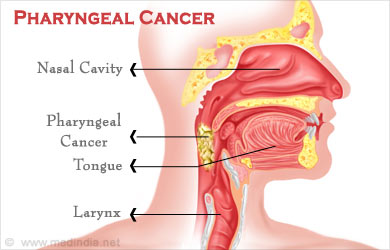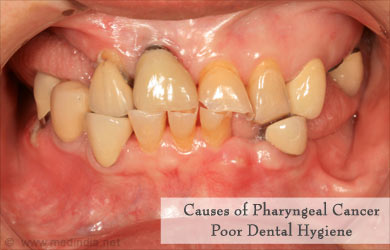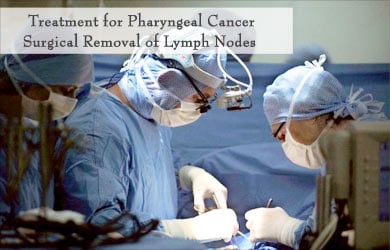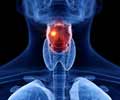- Head and Neck Cancer—Patient Version - (http://www.cancer.gov/cancertopics/types/throat)
- Throat or larynx cancer - (http://www.nlm.nih.gov/medlineplus/ency/article/001042.htm)
- Throat cancer - (http://www.mayoclinic.org/diseases-conditions/oral-and-throat-cancer/basics/definition/con-20042850)
- Oropharyngeal cancer - (http://en.wikipedia.org/wiki/oropharyngeal_cancer)
What is Pharyngeal Cancer?
Pharyngeal cancer, commonly referred to as throat cancer, is a form of malignant tumor that can affect the pharynx, the part that connects the nose to the food pipe.

Anatomically, the pharynx comprises of three distinct regions that include:
- Nasopharynx – This is the uppermost part of the throat that is situated just behind the nasal fossa or nasal cavity and above the soft palate. It serves as a connection between the nose and the lower throat.
- Oropharynx – This is the part of the throat that is located just behind the oral cavity and connects the mouth to the lower part of the throat. It comprises of the soft palate, back third of the tongue, the tonsils and the side and back walls of the throat. This portion of the throat enables the passage of food and fluid from the mouth to the esophagus and it also allows the passage of air through the trachea.
- 3. Hypopharynx of laryngopharynx – Thisportion of the throat is the lower part of the throat that opens into thelarynx and esophagus. A small flap called the epiglottis covers the opening ofthe larynx while swallowing, thus preventing the passage of food into thewindpipe.
Types of Cancer in the Pharynx
Pharyngeal cancer can affect any of the regions of the pharynx such as nasopharynx, the oropharynx or the hypopharynx causing Nasopharyngeal Cancer, Oropharyngeal Cancer and Hypopharyngeal Cancer, respectively. Collectively, they are all referred to as pharyngeal cancer.
Causes of Pharyngeal Cancer
The risk of developing pharyngeal cancer is higher in men as compared to women and it is also more common in adults who are past 50 years of age. While cancer can affect anyone, the risk of pharyngeal cancer is a lot higher if you are exposed to certain risks that include:
- Smoking cigarettes, bidis, a pipe or any other form of tobacco
- Chewing tobacco
- Excessive consumption of alcohol
- Low intake of fruits and vegetables and vitamin A deficiency
- Exposure to asbestos
- Infection with a specific type of HPV virus
- Poor dental hygiene

HPV or human papillomavirus, which increases the risk of throat cancer, is a sexually transmitted disease that can affect both men and women. As is the case with most cancers, the risks often overlap and someone diagnosed with throat cancer could also suffer from lung, esophageal or bladder cancer simultaneously. This could also occur as cancer can spread through the body over a period of time.
Symptoms of Pharyngeal Cancer
Pharyngeal cancer symptoms will not differ much according to which part of the pharynx is affected and only a few symptoms may give you an indication of the exact location of the cancer in the pharynx. Symptoms that could be indicative of pharyngeal cancer include the following:
- Persistent cough and sore throat that does not respond to treatment
- Nosebleeds
- Presence of inexplicable lump towards the back of the mouth or in the neck, throat or nose
- Dysphagia or pain and difficulty swallowing
- Difficulty breathing and hoarseness or vocal changes
- Jaw pain and ear pain, which may also be accompanied by tinnitus

- Headaches and pain behind the breastbone
- Unexplained weight loss
Nosebleeds and tinnitus are most common when the cancer is in the nasopharynx, while difficulty swallowing is generally more indicative of a cancer in the hypopharynx.
Diagnosis of Pharyngeal Cancer
Make it a point to report all your symptoms and provide your doctor with your complete medical history as this will be the first step towards his making a diagnosis. If your doctor does suspect throat cancer he may use the following diagnostic tools:
- Endoscopy or laryngoscopy – Your doctor may use either or both methods to examine the throat and larynx and look for any abnormalities.
- Biopsy – If your doctor notices any abnormalities during the examination, he may collect a tissue sample and send it to a laboratory for testing.
- Imaging Tests – Imaging tests like X-rays, MRIs, CT scans and positron emission tomography (PET) can help your doctor make his diagnosis and can also help him to determine the extent to which the cancer has progressed.
Once your doctor has identified and confirmed the presence of pharyngeal cancer he will determine the extent or stage of cancer using results from imaging tests. This is called staging and the cancer may be classified accordingly into stages 0 to IV
The outcome is a lot more positive in the early stages, which is why early signs of pharyngeal cancer should be attended to swiftly.
Treatment for Pharyngeal Cancer
There are different treatment options for pharyngeal cancer and the suitability of treatment will be determined by factors such as the stage and location of the cancer, the types of cells involved, the general health, and preferences of the patient. The patient will need to discuss the risks and benefits of each approach with the doctor and plan a suitable treatment plan with his help.
Surgical Treatment
- Pharyngeal cancer that is in the early stages and has not spread beyond the throat can be treated using an endoscopy. With a hollow endoscope your doctor can perform a surgery with special surgical tools or a laser to scrape, cut or vaporize the tumor.
- When the cancer does not affect too large a region of the throat, doctors will only need to remove the affected part of the throat, which may be reconstructed. Surgical reconstruction is done to enable swallowing of food. When the cancer has progressed to affect a larger region, it may necessitate removal of the entire pharynx as well as the larynx.
- Surgical removal of lymph nodes through neck dissection is used when required to check if the cancer has spread to the lymph nodes of the neck.

Radiation Therapy
It involves the use of high-energy rays in a targeted manner to destroy malignant cancerous cells. In the early stages of cancer, radiation therapy alone may suffice as treatment, but in more advanced cases, it is usually used in combination with surgical treatment or chemotherapy.
Chemotherapy
It is another standard treatment used in almost all types of cancer. There are different types of chemotherapy drugs that play different roles. Some chemotherapy drugs kill cancer cells, while others make them more sensitive and vulnerable to radiation therapy. For this reason, they are often used in combination with radiation therapy.
Targeted Drug Therapy
Targeted drugs are often used for treating pharyngeal cancer in specific situations. These drugs exploit certain defects that are present in cancer cells. There are several targeted drugs that are still being investigated and depending on the outcome of clinical trials, some of these drugs may soon be available to patients.
Radiation therapy and chemotherapy pose huge risks in terms of side effects, especially when used together. Make sure that you discuss all of the risks and benefits before electing for any treatment procedure.
Complication and Risks
After treatment, patients may suffer from certain complications that include:
- Difficulty breathing and swallowing
- Loss of the ability to speak

- Disfiguration of the neck or facial regions
- Thickening of skin around the neck
Many patients will also need to relearn reflex actions, like swallowing. In other cases, speech therapy may be needed so that the patient can once again communicate verbally.
In addition to complications that may develop after treatment, there are also several side effects that almost all cancer patients have to deal with. Side effects from radiation therapy can include skin burns, fatigue, hair loss, headaches, nausea, vomiting and weight loss. Chemotherapy on the other hand can cause digestive disorders like constipation or diarrhea, hair loss, weakened immunity, bone marrow damage resulting in anemia and low platelet counts, nausea, fatigue, mouth sores and vomiting.






